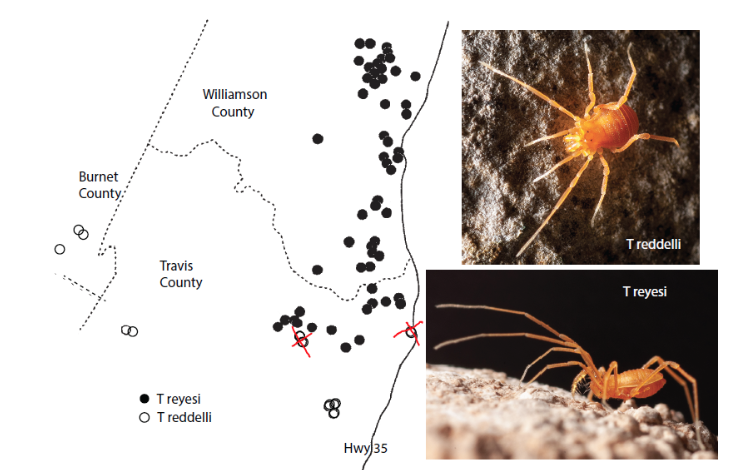5% of profits support Endangered & Threatened Species.
It is very difficult to tell the federally endangered (not Texas state endangered!) Bee Creek Cave harvestman (Texella reddelli) from its closest relative the Bone Cave harvestman (Texella reyesi).

©Juliet Whitsett |Social: @juliet_whitsett_art Bee Creek Cave Harvestman

©Juliet Whitsett |Social: @juliet_whitsett_art Bone Cave Harvestman
COLOR PALETTE SAMPLED FROM IMAGES OF A BEE CREEK HARVESTMAN

SPECIES INFO:
"The Bee Creek & Bone Cave Harvestmen are federally endangered karst, or cave invertebrates. They are related to daddy longlegs (Opiliones), but are troglobitic, meaning they only live underground. Due to limited nutrients in the subterranean environment, they often appear dormant while hiding under rocks. Little is known about the behavior or diet of these reclusive animals. They only exist in a small portion of Central Texas and are endangered due to rapid urbanization in this region. Protecting the mixed Ashe Juniper and oak woodlands above ground helps ensure nutrients make their way down into the caves and contaminants stay out of their sensitive underground habitats."
- Colin Strickland, Biologist
____________________________
It is very difficult to tell the Bee Creek Cave harvestman (Texella reddelli) from its closest relative the Bone Cave harvestman (Texella reyesi). In general, the Bone Cave harvestman is more cave adapted than the Bee Creek (longer legs, reduced eyes, etc.) but it requires a very powerful microscope to see these features and they are variable from north to south (northern critters are more cave adapted than the southern ones in the same species).
Up until recently, the most obvious character used to separate the two was the presence or absence of a retina. The more cave adapted Bone Cave harvestman were considered to be those without the retina and those with retina were Bee Creek Cave harvestmen. However, several specimens in the Jollyville Plateau were discovered that had morphological (body shape/size) characteristics of the Bee Creek Cave harvestman but lacked a retina like the Bone Cave harvestman.
Scientists plan to conduct a larger genetic study to see if there are better diagnostic characteristics they can use to identify them or if genetics is really the only way to tell them apart. Stay tuned.
Of note, you will not find either of these species on the Texas endangered list- according to the Texas Parks and Wildlife Department:
Texella reddelli (Reddell harvestman) is listed as federally endangered but not state endangered or threatened in Travis, Williamson, and Burnet counties. According to our Parks and Wildlife Code, fish and wildlife is defined under Chapter 68 – Endangered Species as “any wild mammal, aquatic animal, wild bird, amphibian, reptile, mollusk, or crustacean…” and does not include terrestrial invertebrates.
RANGE:
Statistical Analysis & Revision of Endangered Karst Species Distribution Austin Area TX Veni & Jones 2021
 FIGURE 1 - (left) Distribution of T. reyesi and T. reddelli, from Ubick
& Briggs (2004). (right) live images of focal Texella species.
FIGURE 1 - (left) Distribution of T. reyesi and T. reddelli, from Ubick
& Briggs (2004). (right) live images of focal Texella species.
WATCH:
SOURCES:
Statistical Analysis and Revision of Endangered Karst Species Distribution, Austin Area, Texas- George Veni, PhD, and Michael Jones
Personal communication with Colin Strickland, City of Austin Balcones Canyonlands Preserve Biologist
SUPPORT:
Shop this art HERE and HERE OR gift to the Threatened Texas Series: Venmo @Juliet-Whitsett (Your patronage donation helps spread the word about Texas' Endangered & Threatened Species).
THREATENED TEXAS SERIES:
There are 148 Threatened Species & 74 Threatened Species in Texas. Each palette & species is unique. I have sampled colors from images of actual Texas Threatened Species and created original art inspired by each group. 5% of the profits from this series enthusiastically goes to help Threatened & Endangered Species.

